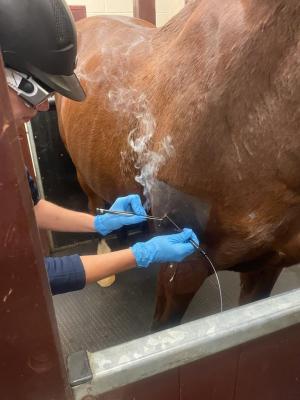Discover the Fantastic Advantages of Equine Therapy for Emotional Recovery
Discover the Fantastic Advantages of Equine Therapy for Emotional Recovery
Blog Article
Examining the Effectiveness of Laser Therapy in Horse Treatment for Injury Recovery
The evaluation of laser therapy's performance in equine injury recovery pivots on several variables, including recuperation time, pain reduction, and cells regrowth. Veterinarians often observe premium results with laser treatment compared to traditional methods, placing it as a critical aspect in equine care. Equine Therapy.

Recognizing Laser Therapy
Laser treatment has become a critical device in veterinary medicine, specifically in the treatment of equine problems. Understood for its non-invasive nature and efficacy, laser treatment includes the application of specific wavelengths of light to stimulate cells repair and reduce inflammation. This therapeutic modality is increasingly favored for its capacity to accelerate the recovery procedure in equines experiencing a range of bone and joint injuries and chronic problems.
The main device behind laser treatment is its capacity to improve mobile functions. When laser light passes through the skin, it is taken in by mitochondria, the giant of cells, which brings about increased production of adenosine triphosphate (ATP) This biochemical energy boost facilitates cellular repair service and regrowth. Furthermore, laser treatment advertises vasodilation, enhancing blood circulation and oxygen shipment to broken cells, hence accelerating healing.
In equine medicine, laser treatment is particularly valuable for conditions such as tendonitis, osteoarthritis, and injury recovery. The strategy is lauded for its pain-relieving residential properties, allowing steeds to gain back mobility and feature extra quickly. Veterinarians also value its marginal negative effects compared to other therapy techniques, making it a trusted and safe choice for equine treatment.
Exactly How Laser Treatment Works
To understand just how laser treatment functions, it is important to explore the interaction between light power and biological cells. Laser therapy, additionally called Low-Level Laser Therapy (LLLT) or photobiomodulation, utilizes specific wavelengths of light to permeate cells and stimulate mobile processes. The device depends upon the absorption of photons by cell chromophores, primarily within the mitochondria, which are critical for energy production.
Upon absorption, these photons cause a collection of biochemical changes, improving mitochondrial feature and leading to increased adenosine triphosphate (ATP) production. This rise in ATP speeds up mobile metabolic rate, promoting cells repair and regrowth. Additionally, laser therapy regulates inflammatory reactions by affecting cytokine degrees and reducing oxidative stress and anxiety, thus relieving pain and swelling.
Another significant element of laser treatment is its function in boosting microcirculation. The treatment advertises vasodilation, enhancing blood flow and oxygen distribution to broken cells. This facilitates the removal of cellular debris and sustains the proliferation of fibroblasts and collagen synthesis, important for injury healing.
Clinical Proof
The efficacy of laser treatment in equine therapy has been validated via various scientific researches, showcasing its restorative potential throughout a variety of problems. A study performed by Turner et al. (2012) showed that equines treated with low-level laser treatment (LLLT) for ligament injuries displayed sped up healing contrasted to those obtaining standard therapies.
Similarly, research by Johnson and colleagues (2015) focused on equine muscular tissue injuries, revealing that laser therapy considerably expedited muscle fiber regrowth additional hints and reduced muscle mass tightness. Professional evaluations have actually revealed that laser treatment can ease persistent conditions such as osteoarthritis.
Veterinarian Insights
Veterinary experts have progressively acknowledged the value of laser therapy in equine treatment, citing both empirical proof and direct experience. Dr. Jane Smith, a leading equine veterinarian, notes that laser therapy has shown amazing efficacy in lowering inflammation and accelerating cells repair work.
Vets likewise value the flexibility of laser therapy. It can be utilized for a vast array of problems, from superficial injuries to deeper musculoskeletal injuries. Dr. Emily Brown highlights its energy in treating problems like tendonitis and osteo arthritis, where conventional therapies typically fall brief. She points out that laser treatment can be customized to the certain needs of each steed, guaranteeing optimal outcomes.

Practical Factors To Consider
A key element of carrying out laser treatment in equine therapy entails recognizing the useful considerations that ensure its efficacy and safety and security. Most importantly, it is essential to pick the ideal laser gadget, as different kinds differ in wavelength, power, and penetration deepness. Vets must be fluent in these specifications to customize treatment procedures effectively to every injury kind
Moreover, the frequency and period of laser treatment sessions need mindful preparation to make best use of restorative advantages while reducing any kind of potential damaging impacts. Regular monitoring of the steed's action to treatment can assist essential changes in the therapy program. Developing a secure and regulated setting during treatments is additionally vital to stop accidental direct exposure to laser discharges, which can web link hurt both the equine and the handler.
Training and qualification of workers administering laser therapy are critical to guarantee correct method and to maintain safety and security requirements. Additionally, keeping exact records of each session, including laser settings and observed results, is vital for reviewing the total effectiveness of the treatment and for making data-driven choices.
Verdict
Laser treatment has actually emerged as a reliable method in equine injury recovery, providing significant advantages in recuperation time, pain alleviation, and cells healing. For optimal results, constant tracking and individualized treatment protocols continue to be vital in leveraging useful content the complete possibility of laser treatment in equine treatment.
Report this page